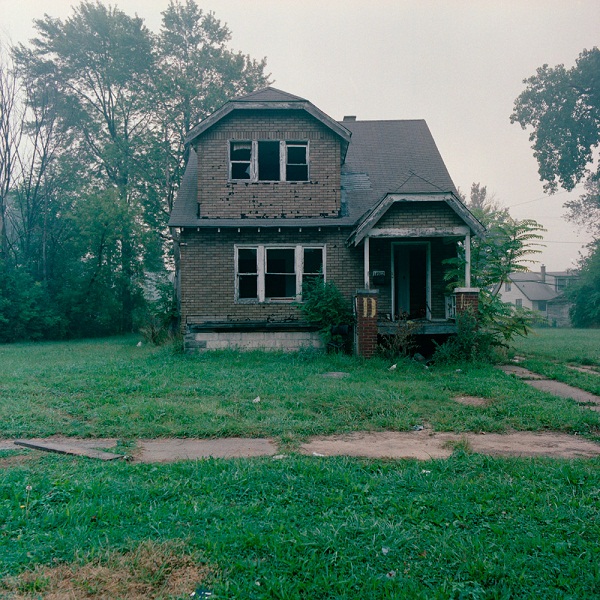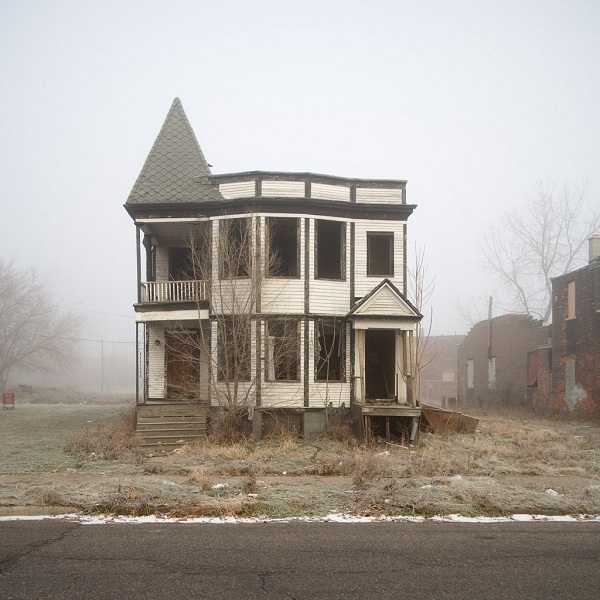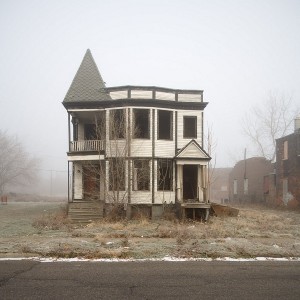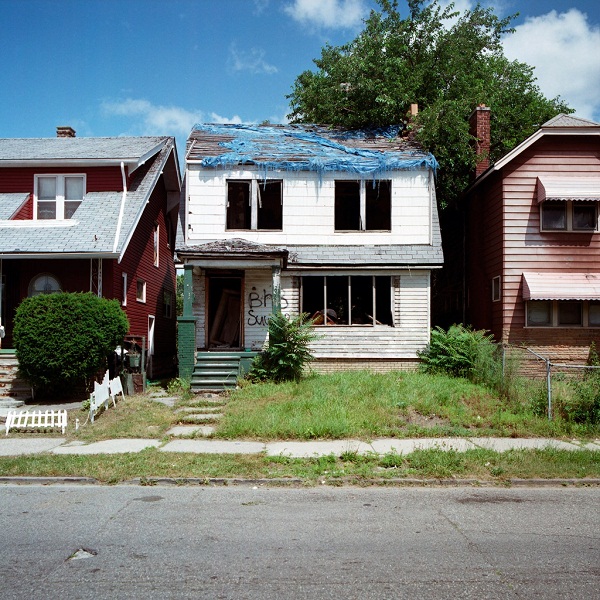Artist of the Week 8/15 – 8/21: Kevin Bauman Exposes ‘100 Abandoned Houses’
GALO: Have you ever researched the history of the areas where you photograph houses, such as those in the Brush Park area, to find out why they are abandoned?
KB: Brush Park was kind of the wealthy enclave of Detroit back in the last century into the early 1900s. It wasn’t too long after it was established and that these large, impressive houses were built that the economy started to crumble, primarily because Henry Ford moved his headquarters several miles away to Dearborn. After that [occurred], people who were involved in the auto industry moved to that area as well. As soon as that happens, the money tends to follow. [It wasn’t] too long after that the area started to decline.
Detroit started to decline in the ’60s when wealthy white citizens of Detroit moved to the suburbs in large numbers. The whole population started to decline. It becomes hard for areas losing wealthy citizens to maintain their infrastructure, so a lot of the houses in Brush Park were divided up into boarding houses and apartments.
GALO: What emotions do you go through when discovering a new abandoned house to photograph? Is it excitement to add to your collection, or depression because of the state of your subject?
KB: As a photographer, it’s easy to see [the houses] as something kind of removed from the people who lived in them at one point. It was, on the one hand, very exciting and interesting to get what you thought were interesting images, at least to me. It was 100 percent a personal project.
On the other hand, you would see all these abandoned houses, and you would meet people in the area and see the difference between the wealthy suburbs and areas with maybe just a few people and garbage on the streets. Some things were a little depressing. There are a lot of mixed emotions. On the one hand, you’re trying to make the best photographs you can make. And on the other hand, you’re very aware of what these things mean to other people.

Kevin Bauman’s “100 Abandonded Houses” series. Photo Credit: Kevin Bauman.
GALO: Have you had the opportunity to exhibit 100 Abandoned Houses anywhere?
KB: They have been shown in a couple of galleries. There’s one in Grand Rapids, [Mich.]. They have a big city-wide exhibition called Art Prize. Not all 100 have been displayed for an exhibition at the same time for practical reasons. There’s a gallery in Barcelona, Spain, Gallery Victor Lope that has exhibited the photos as well. There’s another one in New York, it’s kind of interesting — it was a digital exhibition. They had display screens up on which they displayed digital images.
GALO: What sort of responses have you received from those who have viewed your photographs?
KB: From what I was told, there was a lot interest. I don’t know if it’s kind of a voyeuristic feeling or more intrigue, but certainly for people who aren’t from Detroit, it’s not easy to understand how there could be so many abandoned houses. So, I think for some people, it’s very surprising, shocking, maybe.
The reactions that I [have] had from people from Detroit are very positive. I think I had two negative reactions, one was a phone call and one was an e-mail. They were upset that I had portrayed Detroit in such a bad light. Everyone else has either thanked me for showing that part of Detroit or just enjoyed the images for what they are.
It sparked further conversation and dialogue about Detroit that was very interesting. There are people who used to live in Detroit, who told [me] stories about when they were there and why they left.
GALO: You estimate that there are 12,000 abandoned houses in Detroit. What, in your opinion, makes a particular house better subject material for a photograph than others?
KB: Some of it was access. Some would be more difficult to photograph in a similar way than others. I liked them in areas that [had] quieter and lower traffic, so I could focus on what I was doing. If you photograph in busier places, you get asked a lot of questions, and that can really slow down the process. I also enjoy that and would sometimes do that, but if you want to photograph five or six houses in a morning, you want to keep going. I liked to pick ones that were isolated or didn’t have other houses around them or maybe one that contrasted from those around them.
GALO: Did you have any particularly memorable experiences going out to photograph the houses?
KB: There were a lot of interesting conversations with people. A lot of people thought I was with the city and wanted to know if I was going to take the houses down, and they were a little disappointed to find out I was just taking photos of it. There were some people who had lived there for 20 years and watched the area change; watched as their neighbors moved away. Some of them had inherited a house and would move back after years away. For the most part, the experiences have been good. There are a few scarier ones, nothing too bad. I did have an encounter with a pack of wild dogs once, but I didn’t get hurt.
GALO: Did you ever attempt to go inside one of the houses, or are you exclusively interested in the exteriors?
KB: I did go in a few houses. I went by myself, which was probably not the smartest idea for me to do alone in an abandoned building. I did occasionally take pictures inside, but I focused on the outside. That’s how the project developed. I just decided to focus on what I had kind of found to be the thing I was most interested in.
GALO: Are there any particular houses that you especially remember or wanted to photograph, and why?
KB: There’s one that looks like a little chapel. I found that one to be really interesting to me. Unfortunately, two or three years ago, someone caught it on fire, so they had to knock it down. That’s one that stands out. There’s another in the fog, a white bell house. It was morning and the fog came out. It’s been one of the most popular ones. It turned out to be very striking because of the conditions.

“A foggy morning in Detroit.” One of the 105 photographs that Kevin Bauman took for his “100 Abandonded Houses” series in the city of Detroit. Photo Credit: Kevin Bauman.
GALO: Although you said sometimes you would find entire streets or neighborhoods of abandoned houses, you keep the structure of your photographs relatively similar throughout, putting the central focus on one single building. Why did you decide to focus on individual houses as opposed to capturing the magnitude of abandonment in some areas?
KB: I just wanted to show a variety of houses in Detroit. Sometimes, I took photos down the street of a bunch of abandoned houses, but they didn’t end up in the series because they didn’t fit in.
GALO: Do you have any plans or ideas for other architecture-focused series or projects?
KB: I’ve photographed a series of the Michelin Central Train Station in black-and-white. Like a lot of people, I have a fascination with it because it was, at the time, the largest train station in the world. It was designed by the same architects as Grand Central Station, so I have some exterior shots of that. I [have] also photographed a lot of buildings in Detroit and [I have] a lot of very urban-themed pictures.
GALO: Is there anything else about the 100 Abandoned Houses series you’d like others to know about?
KB: it was all done on one camera that is 50 years or older and with one lens. There was nothing elaborate, just a lot of time out there taking pictures in the cold and in the rain, and a whole lot of conversations with a lot of people. It’s been a very satisfying project, in that I never expected it to be anything and it turned out to be hugely successful, in my mind. And it has really allowed me to meet a lot of interesting people.
Also, I donate $10 from each print purchased from the site, and have been able to donate nearly $2,000, to Detroit charities.
You can view Kevin Bauman’s entire series by visiting the following site: http://www.100abandonedhouses.com



